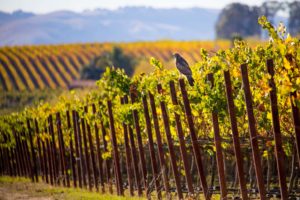Late afternoon sunlight was brilliant on the leaves of corn, tomato, and tomatillo plants. Sunflowers planted by schoolchildren were growing in a tight spiral. Squash and beans were wrapping eager tendrils around teepees of bamboo.
The Mexican national soccer team was playing Peru that day, so only a few gardeners were weeding and watering their garden beds at Bayer Farm in Roseland, a working-class Latino section of Santa Rosa. But on most afternoons, 20 or 30 people come to this organic farm and community garden surrounded by apartment buildings and small, closely built houses. Founded four years ago, the farm transformed part of a six-acre vacant lot into a community hub in an area badly lacking in public green spaces. The nearby main street is lined with strip malls where the Dollar Store and Mendoza’s Super Mercado alternate with empty storefronts.
“It is a very low-income neighborhood,” says Magdalena Ridley, who lives a block away and runs the farm for the local nonprofit LandPaths. “We have a lot of health problems like obesity and diabetes. Organic food is expensive, a lot of people don’t drive. So the ability to grow food is something our gardeners really treasure.”
- The farm’s welcoming hand-painted sign is a beacon in a neighborhood with very few accessible outdoor public spaces. Photo by Stephen Joseph, stephenjosephphoto.com.
There are 36 private plots tended by individuals and families; more people are on the waiting list. And there’s a public garden where anyone can volunteer and go home with fresh vegetables. But the farm offers more than a place to grow things. Each summer, about 70 children come for a free lunch program; the rest of the year the farm is an outdoor classroom where kids learn about food, nature, and science.
“We have students come from local schools to work in this area,” explains Jonathan Bravo, who oversees the gardens. “For example, this is called the ‘Garden of Giants,'” he says, gesturing to the sunflower patch. “Second-graders saved the seeds last year and started them in the greenhouse.”
Even on a quiet afternoon, Bayer Farm is a meeting place. A gate has been cut in the fence of the apartment building next door; a small boy comes through it to play, and later a man steps in carrying a wire cage holding four chickens. He releases the birds into a coop built along the fence.
“This place is very pretty; it brings life,” says the man, Javier Pichardo, who first came here when he brought his daughter to a bilingual story-time for children. He’s now an active volunteer and has a garden plot. “You get to be in contact with nature, see your neighbors, relax the body.”
Besides providing healthy food, creating common space is a main goal of Bayer Farm. “It’s really important for our community to have a place to come together in general, because we don’t have public spaces,” says Ridley. Several of the gardeners echo this sentiment. “If we didn’t have this plot we’d just watch TV,” says Reyna Arreola as she headed home with a big bunch of radishes.
Ernesto Lomeli, a quiet, mustachioed man, also comes to the garden for company. “Otherwise life is boring, because I don’t smoke and I don’t drink,” he says with a laugh. But then he turns somber: His wife, fighting cancer, has gone back to Mexico with their children, and he lost his right pinkie in a mill accident. Other gardeners helped him plant this year’s corn and tomatoes.
Today, Bayer Farm is about to expand, using a $5 million grant from a state fund for parks in underserved areas. Soon the rest of the six-acre lot surrounding the gardens will become a community park, planned largely by people in the neighborhood.
“People are excited,” Ridley says. “They really want this park to be a model of sustainability and respect for the earth.”
Learn more at landpaths.org.
Find more Food Landscapes resources at baynature.org/foodlandscapes. And check out our video from Bayer Farm’s fall festival.

.jpg)




